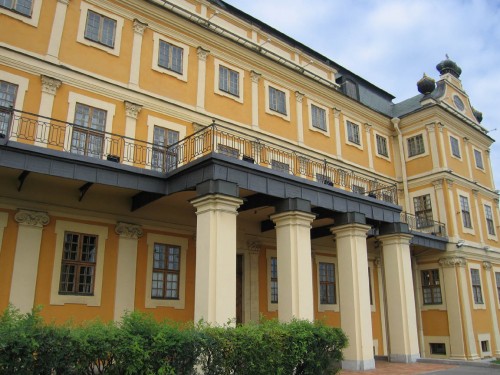The Menshikov Palace, situated on Vasilyevsky Island, was the first monumental residence built from stone in St. Petersburg. The Palace was built for Aleksandr Danilovich Menshikov who was a Prince of the Russian Empire and a very close associate of Peter the Great.
In 1687, Aleksandr Menshikov, the barely literate son of a groomsman, became a servant to Peter the Great. In 1697, he became the Tsar's favourite and permanently accompanied him on all of his journeys. Thanks to his loyal and earnest nature and outstanding military and administrative abilities, Menshikov obtained significant influence at court and soon acquired the title of prince. In 1703, Menshikov was appointed Governor-General of Ingria, a region of Russia that was later renamed the St. Petersburg Governorate. In May 1710, after a five year absence fighting in battles in the Baltics and Poltava, Menshikov finally returned to St. Petersburg as a war hero and began construction on his official residence on Vasilyevsky Island which had been granted to him by Peter I.
The construction of the Menshikov Palace began in 1710 under the supervision of Italian architect Giovanni Mario Fontana and was completed by Johann Gottfried Schaedel in 1721. The Menshikov Palace was built in Peter the Great's Baroque style. Initially the Palace comprised the main building, with the front facing the Neva River, which was the city's main thoroughfare in those days, and several wings that formed a small courtyard in front of the Palace. The building was surrounded by a well-attended garden, which, unfortunately, has not survived to the present day. The garden was decorated with numerous sculptures, beautiful fountains, dark grottoes and greenhouses with exotic plants. A pier was built on the bank of the Neva River in front of the Palace so that small ships could dock right by the Palace's grand entrance.
The Menshikov Palace looked impressive: its façade was decorated with three layers of pilasters and capitals carved out of stone. The central part of the building was finished with an attic adorned with sculptures and risalits along the side, curved with regal crowns on the top. The architectural decor of the Palace combines various styles. The strict symmetrical floor plan and high foyers with arcades are reminiscent of an Italian Renaissance palazzo, and the cobalt coloured glazed tiles that cover the walls, the ceilings and the stoves in some rooms are designed in the Dutch style.
The interiors of the Palace were decorated with gold, silver, marble, expensive types of wood, scenic paintings and mouldings, painted Dutch tiles, antique and modern Italian sculptures, large Venetian mirrors, crystal chandeliers and Chinese silk wallpaper and tapestries.
The furniture of the Palace was no less luxurious and included chairs and settees emblazoned with coats of arms and tables with gold-plated feet. The Palace featured the richest art collections of the time that included paintings, sculptures, and other pieces of art and coin collections. Unlike Peter I, who preferred to live a modest life, Menshikov was fond of luxury and lived on a grand scale. His palace was the largest and the most magnificent building to be constructed in the city thus far, superior even to the Tsar's residence. It was therefore chosen to host various ceremonial diplomatic receptions, famous Peter the Great's assemblies and gala celebrations.
The Palace was so magnificent palace that it was said that Menshikov had built it using public money and when this fact came to the Tsar's knowledge, Peter I summoned Aleksandr and whipped him with his own club.



